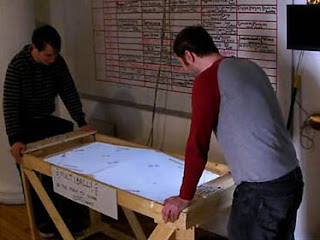Moving Parts consists of a wooden table with players stationed at opposite ends. A digital pinball game is projected onto the tabletop, and players control ball launch and flippers with physical controls.
At the start of the game, players can choose one of four variations—competitive, cooperative, synchronized, and multiball. In each version, players score points by hitting bumpers arranged on the table, progress through levels by hitting each bumper at least once, and, as in typical pinball, use the flippers to keep the ball in play for as long as possible. The rule variations affect whether the score is individual (competitive and multiball) or shared (cooperative and synchronized), and in the synchronized version players share control of all the flippers.
In addition to my usual interest in playing with the boundaries between physical and digital interfaces, all of this was a somewhat arcane way to watch how people play games together, and how changing the way a game works changes how people relate to each other. The game was iterated and play-tested over a couple of months on the ITP floor, and was more extensively play-tested at the 2008 Spring Show.


I was mostly able to collect anecdotes and make some tentative generalizations—some obvious things like ‘players tend to talk more when the game requires less focused concentration,’ but some less obvious, like ‘players tend to talk and laugh more when competing, while they apologize and appear more anxious when cooperating.’ Overall, it illustrated that game mechanics and rules do affect how people socially interact with each other in the context of the game, and not necessarily in simple ways. (Delving into more specifics of how that all works is of course a longer-term prospect.)













